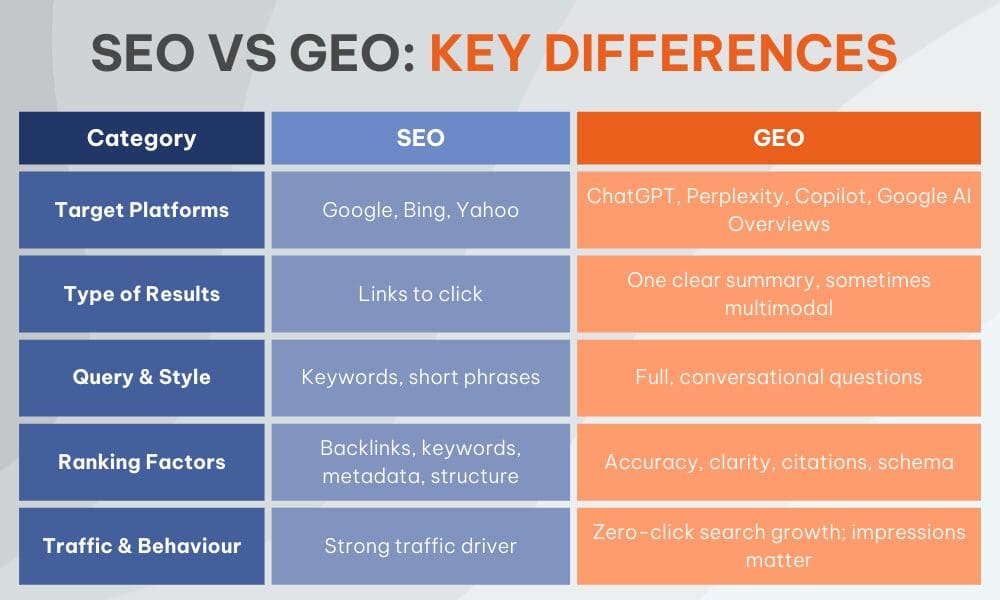SEO vs GEO: The Future of Search Optimisation




SEO has shaped digital marketing for many years, and now, AI search engines such as ChatGPT, Copilot, and tools like Google AI Overviews are changing the game. In the UK, around 36% of adults (aged 16–75) have used a generative AI tool, which equates to roughly 18 million people (Deloitte). This level of adoption shows that generative AI isn’t just a niche trend; it’s becoming part of how people search and consume information.
It is important to understand the difference between SEO and GEO so that you can stay visible online. Throughout this blog, we will break down both, show how they differ, and explain how to optimise for maximum reach.
SEO, or Search Engine Optimisation, is how websites become discoverable on search engines such as Google. It works through several core processes, including crawling, indexing, and ranking, all of which determine whether your content appears when someone searches for it.
The key pillars of SEO include technical SEO, content optimisation, backlinks, user experience, and metadata. Each plays a distinct role in improving visibility:
SEO still plays a crucial role in driving organic traffic, providing long-term stability, and increasing discoverability. For example, targeting “best mattresses for side sleepers” ensures your website appears for users searching with that exact need and intent.
GEO, or Generative Search Optimisation, is the practice of creating content that AI-powered systems use to generate answers. This includes tools like Google AI Overviews, ChatGPT, and Microsoft Copilot. Generative engines analyse and summarise content, often citing sources and presenting information in text, images, or other multimodal formats. As AI adoption grows, GEO is becoming increasingly important because users expect fast, accurate, and context-rich answers.
For example, instead of optimising for the keyword “best mattresses for side sleeping” like traditional SEO, GEO content answers a conversational query such as: “What mattresses are most comfortable for people who sleep on their side?” A clear, concise paragraph, with headings and bullet points, is more likely to be picked up by AI tools.
By designing content with GEO in mind, businesses can reach users through AI-generated answers, capture zero-click traffic, and strengthen their visibility in the evolving search landscape.

Don’t think of GEO and SEO as rivals; they complement each other. Users move between AI tools and traditional search often. GEO tends to work best on a strong SEO foundation, which is technically sound, authoritative, and content-rich. Optimisation for both ensures maximum visibility, boosting traffic from both, which is supported by multi-platform authority such as reviews, mentions, and structured data. In fact, 81% of users start on Google but cross-check with social media or AI tools before making a decision (Gartner), highlighting the importance of being visible across multiple platforms.
Example:
Imagine a blog post on “side-sleeper mattresses.”
SEO-focused content targets the keyword in headings, meta descriptions, and internal links, helping it rank in Google search.
GEO-focused content answers a question like, “What mattress is best for people who sleep on their side?” in a clear, concise paragraph with bullet points. AI tools like ChatGPT or Google AI Overviews may summarise and cite this content in a zero-click result.
Together, this content reaches users both via traditional search and AI-powered summaries, maximising visibility and brand authority.
Optimising for both ensures your brand is seen on multiple platforms, strengthens credibility, and captures traffic from different user behaviours. It also supports multi-platform authority through reviews, mentions, and structured data, which further increases your chances of being referenced by AI tools.
You may be wondering, how do I optimise for GEO? Well, doing so means creating content that AI can easily understand, summarise, and present in response to queries that are conversational. In the UK, adoption is already significant, with Deloitte reporting that 36% of adults have used a generative AI tool, so creating content that works for these systems is becoming essential. For example, think about answering a query that is asked to an Alexa, it will be a lot different to a written query on Google.
Focus on being factual, concise, and direct. Structure your content for clarity using headings, lists, and FAQs, with credible sources to back up your claims. It is also important to incorporate schema markup and structured data to help generative engines recognise and cite your content. By doing this and strengthening your brand authority across multiple platforms, you can improve your chances of being featured in AI-generated answers, especially when you keep your content up-to-date and fresh.
Key GEO optimisations:
SEO optimisation focuses on traditional search, such as helping search engines crawl, index, and rank your content. Ensure that your keywords are researched and strategically mapped through sites such as Semrush, and that your content satisfies user intent, quality over quantity. Optimise on-page elements such as titles, meta descriptions, headings, and internal links. Technical SEO, including site speed, mobile optimisation, and proper indexing, is essential. It is key to build authority for your website through backlinks, digital PR, and rich content that is helpful and demonstrates expertise.
Key SEO optimisations:
As search continues to evolve, three key trends are set to shape how businesses optimise for both SEO and GEO:
Expertise as a Ranking Signal: E-E-A-T is critical for both SEO and GEO. Authorship, case studies, and thought leadership matter. They’re looking for real experience, real credentials, and real proof that you’re trustworthy. Things like author bios, case studies, reviews, and real examples make your content more trustworthy to both Google and AI.
Diversified Search Journeys: Users switch between AI tools, social, and Google. A blended strategy is essential. People don’t just rely on one platform anymore; they search on Google, then ask ChatGPT, then check TikTok or Instagram, then go back to Google. Your brand needs to show up in more than one place.
Zero-Click Search Growth: More answers delivered directly; rethink tracking and reporting. Visibility matters just as much as traffic; you might still get seen, but you may get fewer clicks. This is because people can get the answers without clicking through to your website.
If you’re looking to boost your visibility across various platforms, our team at Clever Clicks Digital can help. Get in touch to explore a strategy tailored to your business and talk all things digital marketing with us today.

Discover the top digital marketing trends set to shape 2026 from AI-driven personalisation to immersive content and evolving SEO strategies. Stay ahead of the curve.
Read full blog
Learn how to start a successful YouTube channel for your business in 2025 from content strategy and branding to optimisation tips that boost growth and visibility.
Read full blog